
The right fan makes a big difference in your space. You can use an axial fan for high-volume, low-pressure needs like cooling large rooms or warehouses. A duct fan works best in spaces with long duct runs or where you want strong airflow through tight spaces.
Matching the fan type to your room size, ductwork, and noise needs ensures comfort and efficiency. Longwell offers both axial fan and duct fan solutions, along with expert support to help you get the best performance for your project.
Key Takeaways
Axial fans move lots of air very fast. They work best in big open places like warehouses or large rooms.
Duct fans make stronger pressure to push air far. They are good for HVAC systems and small tight spaces.
Pick a fan by looking at your room size and duct shape. Think about noise, energy use, and comfort to save power.
Install fans the right way and clean them often. This helps fans stay quiet and last longer. It also makes airflow better and lowers costs.
If you are not sure, ask experts for help. They can help you pick the right fan and stop expensive mistakes.
Quick Comparison
Airflow & Pressure
It is important to know how airflow and pressure work. Axial fans move air straight ahead. They are best for open spaces. These fans move a lot of air fast. Duct fans can have mixed flow or centrifugal designs. They push air through long ducts or tight spots. Duct fans make higher static pressure. This helps them move air past filters or bends in ducts.
Here is a simple table to help you compare:
Fan Type | Airflow Capacity (CFM) | Static Pressure (inH2O) | Typical Use Case |
|---|---|---|---|
Axial Fans | Higher | Lower | Open rooms, warehouses, general cooling |
Duct Fans (Centrifugal/Mixed Flow) | Lower | Higher | Long ducts, HVAC systems, spaces with obstacles |
Axial fans give more airflow in open areas. Duct fans work better where there is more resistance. They keep air moving where it is needed.
Noise & Efficiency
Axial fans use special blade shapes to lower noise. They also help save energy. These fans move a lot of air with less sound. This makes them good for places where people want comfort. Duct fans, like inline and centrifugal types, are also made to be quiet. Inline duct fans are small and quiet. They are great for homes. Centrifugal duct fans stay quiet even at high speeds. They work well in big buildings or factories.
Axial fans use smart designs to cut noise and save power.
Centrifugal duct fans save more energy in high-pressure systems.
Both types help make air better and keep spaces comfy.
Best Uses
You should choose the right fan for your space. Axial fans are best for big, open rooms. They move a lot of air quickly. Duct fans are better for long ducts or tight corners. They are good when air must go through filters or vents.
Tip: Pick axial fans for cooling big spaces. Use duct fans for moving air in tricky systems.
Axial fans: Warehouses, server rooms, greenhouses, open offices
Duct fans: Bathrooms, kitchens, HVAC systems, workshops, factories
Axial Fan Basics

How It Works
An axial fan moves air straight along its axis. You can find this fan in homes and big factories. The blades look like airplane propellers. When the blades turn, they lift the air forward. This makes a steady stream of air. Axial fans do not use centrifugal force at all. They depend on blade shape and spinning to move air. This gives a small pressure boost. These fans move a lot of air fast. That is why axial fans are great for places needing lots of fresh air.
Tip: Guide vanes help axial fans work better and save energy.
Pros & Cons
It is important to know the good and bad sides before picking an axial fan.
Pros:
Moves lots of air with little energy.
Small and light, so it fits tight spots.
Simple design makes it easy to put in and fix.
Runs quietly in most places.
Cons:
Not good for high-pressure or long ducts.
Best for open spaces with few blocks.
Here is a simple table to help you compare:
Feature | Axial Fans |
|---|---|
Airflow Volume | High |
Pressure Capability | Low |
Size | Compact |
Noise Level | Low |
Maintenance | Easy |
Where to Use
You can see axial fans in many places. Experts suggest them for big rooms and warehouses. They also cool electronics and server rooms. Factories and greenhouses use them for air flow too. Axial fans are best when you need lots of air but not much pressure. Their small size helps them fit in tight areas. If you want to move air fast, an axial fan is a good pick.
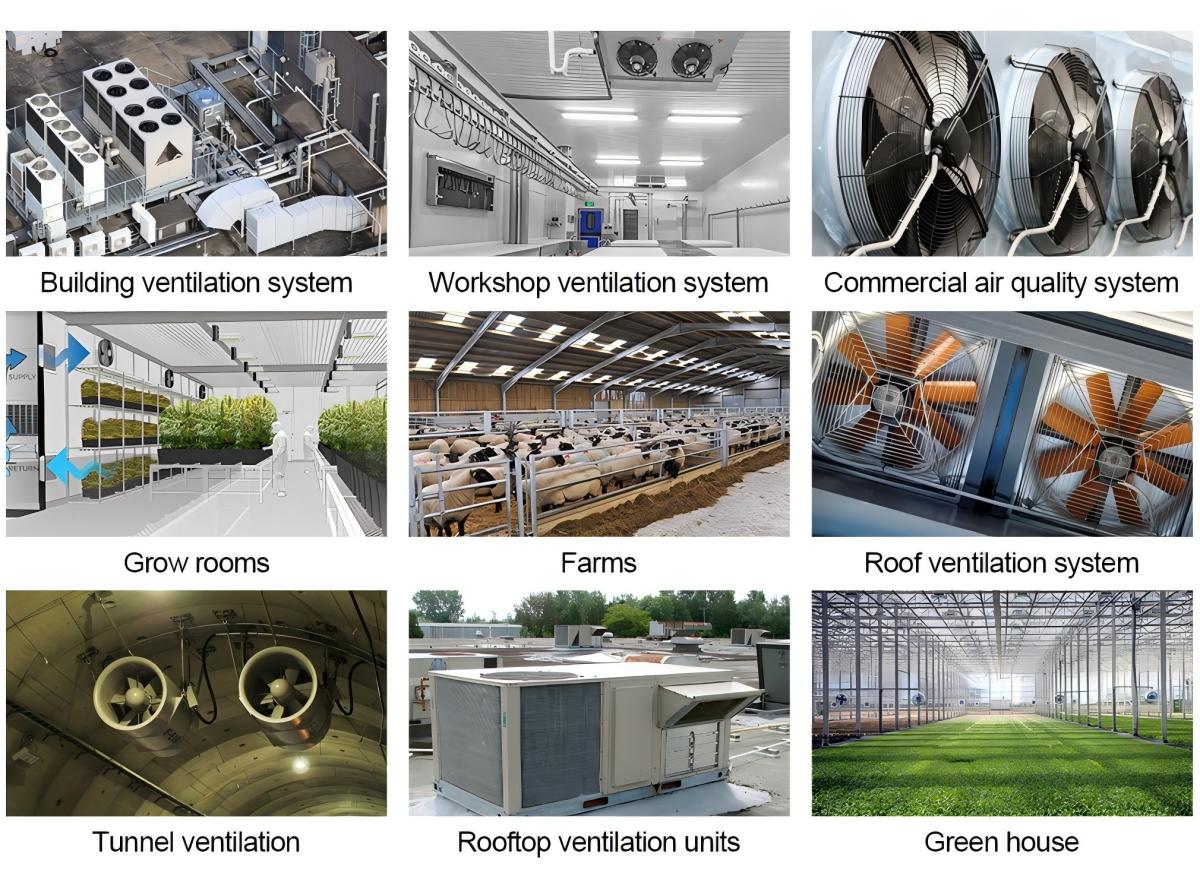
Note: Axial fans are great for moving fresh air in big rooms and keeping spaces comfy.
Duct Fan Overview
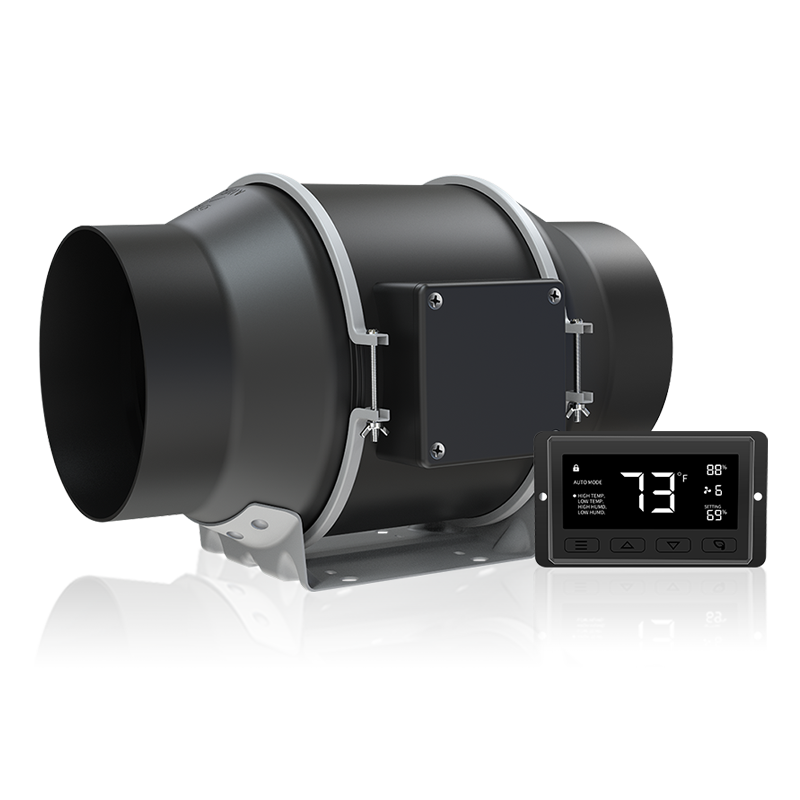
How It Works
A duct fan helps move air inside a duct system. You put the fan inside the duct. It can pull or push air through the duct. This helps control air in places with long or twisty ducts. Many duct fans use mixed flow or centrifugal designs. These designs make strong pressure. Air can go far without slowing down. Some models have EC motors. These motors make the fan quieter and save energy. Longwell has many duct fans from 4-inch to 12-inch sizes. You can get ceiling duct fans, inline centrifugal fans, and very quiet models. Many fans have speed controls, temperature sensors, and backdraft dampers. These features help you control the fan better.
| Product Categories | Motor Types | Advanced Features and Accessories |
Explore Longwell Duct Fans
Discover our versatile, energy-efficient duct fans designed for quiet, reliable ventilation in any space.
Pros & Cons
There are many good things about duct fans:
They give strong airflow for big duct systems.
They are quiet, especially with EC motors and mixed flow types.
They save space because they fit inside ducts.
You can change settings with speed controls and sensors.
The blades are covered, so they are safer.
But there are some things to think about:
Big fans can get loud if they run fast.
You need to clean them often to keep them working well.
It can cost more to put them in for large jobs.
Where to Use
You can use duct fans in lots of places. People put them in bathrooms, kitchens, workshops, and factories. They work well in HVAC systems with long ducts or filters. You also see them in big buildings and factories that need lots of air. Longwell has many duct fans for homes, businesses, and factories. Their team helps you pick the best fan and gives support everywhere.

Tip: Pick a duct fan if you need strong airflow in places with long ducts or lots of bends.
Choosing the Right Fan
Space & Airflow Needs
You need to match the fan to your space and airflow needs. Start by measuring the size of your room or area. Use the square footage to find the base airflow, usually measured in cubic feet per minute (CFM). If your ceiling is higher than 8 feet, multiply the base CFM by the ceiling height divided by 8. This gives you the adjusted airflow needed for your space.
Next, look at your ductwork. Long ducts, sharp bends, or extra filters add resistance. This resistance, called static pressure, makes it harder for air to move. If your system has many bends or accessories, you should choose a fan that can handle higher static pressure. Sometimes, it helps to pick a fan that can move about twice the airflow you think you need. This ensures you get enough ventilation, even if the system is hard to measure.
Check the size of your space and calculate the base airflow.
Adjust for ceiling height and add extra airflow for hot or humid climates.
Count the number of bends, filters, and accessories in your ductwork.
Choose a fan that matches your airflow and pressure needs.
Make sure the fan fits your ductwork or piping.
If you have a simple, open space, an axial fan works well. For long or complex ductwork, a duct fan is often the better choice. Always match the fan type and size to your application, such as a bathroom, kitchen, or workshop.
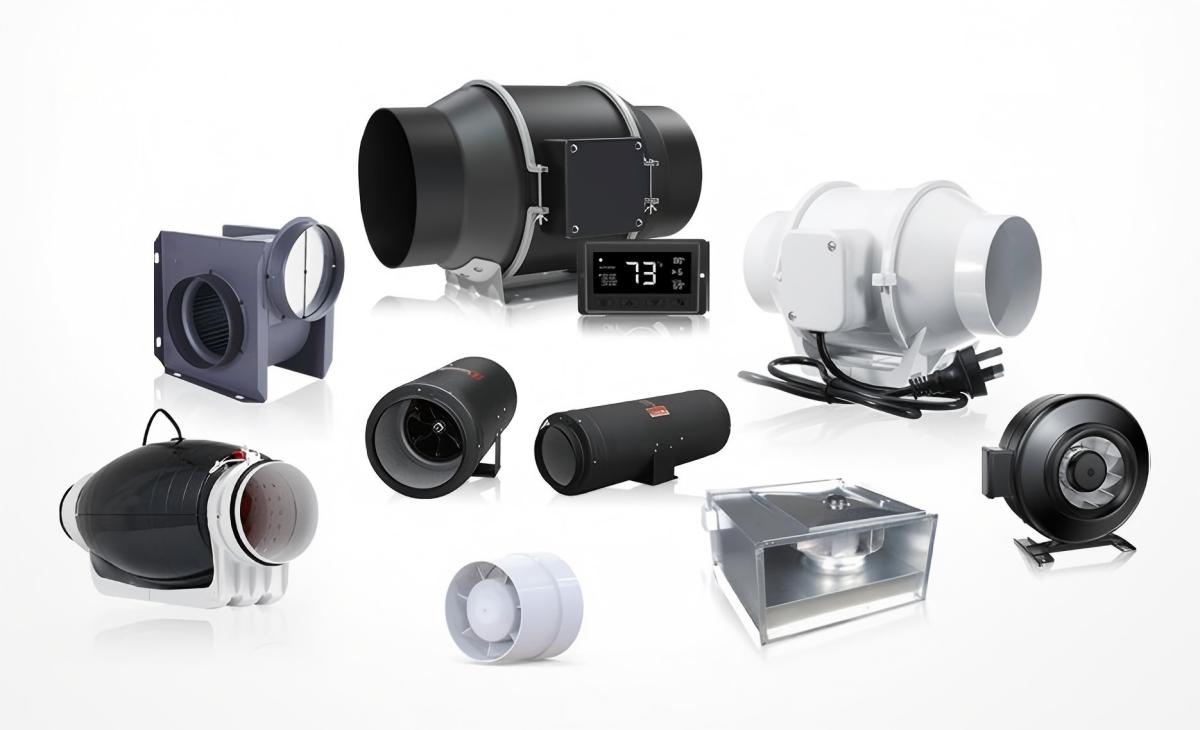
Noise & Efficiency
Noise matters, especially in places where people spend time. Fans have sound ratings measured in sones. For bathrooms and utility rooms, experts recommend fans with a sound level of 2.0 sones or less. Lower numbers mean quieter fans. In quiet spaces, aim for 1.0 sones or less.
Ventilation Fan Type | Maximum Allowable Sound Level (Sones) |
|---|---|
Range Hoods (≤ 75 W) | 2.0 |
Bathroom and Utility Room Fans (10-89 CFM) | 2.0 |
Bathroom and Utility Room Fans (90-200 CFM) | 2.0 |
Bathroom and Utility Room Fans (201-500 CFM, max speed) | 3.0 |
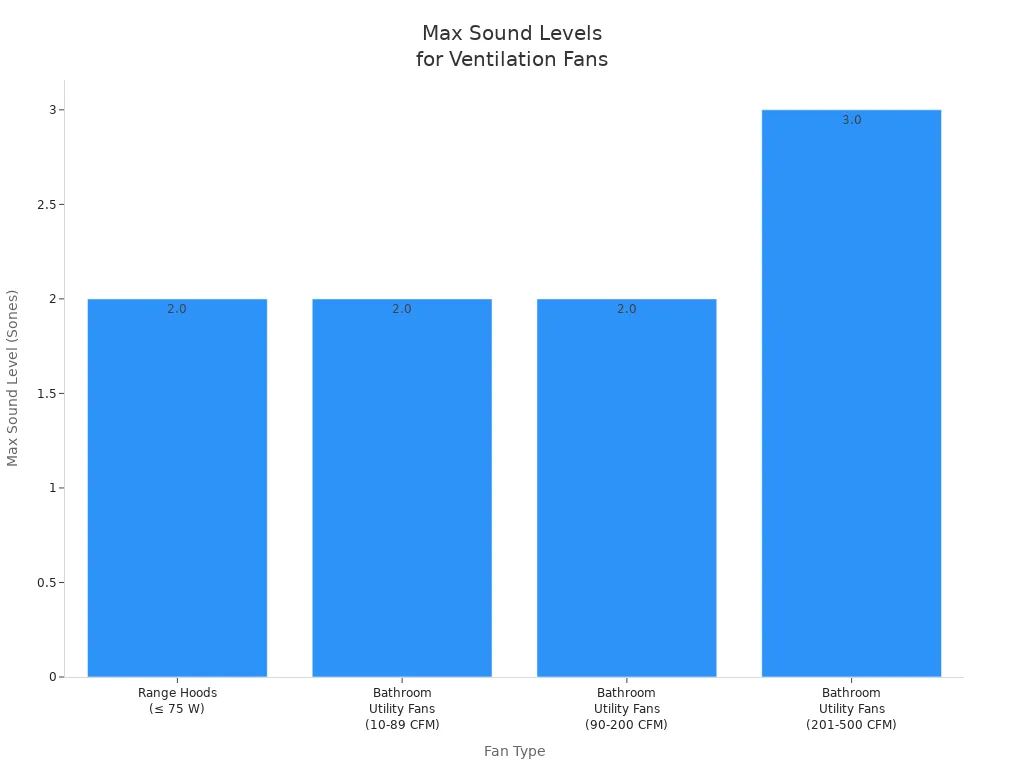
Energy efficiency also affects your choice. Fans with EC motors use up to 30% less energy than regular AC motors. These motors waste less energy as heat and last longer. Variable speed control lets you adjust the fan to match your needs, saving even more power. Over time, energy-efficient fans lower your electricity bills and reduce maintenance.
Choose fans with high motor efficiency to save power.
Use variable speed controls to match airflow to demand.
Larger fans running at lower speeds can be more efficient than several small fans.
Energy-efficient fans help reduce air conditioning use and lower costs.
If you want the quietest and most efficient option, look for duct fans with EC motors or advanced controls. Axial fans also offer good efficiency in open spaces, especially when you use high-volume, low-speed models.
Installation & Maintenance
Proper installation and maintenance keep your fan working well. When you install a fan, make sure the ductwork is straight and free from sharp bends near the fan. Place elbows and dampers at least two to three duct lengths away from the fan. This helps air flow smoothly and reduces noise.
Avoid placing elbows or dampers too close to the fan inlet.
Use turning vanes or straight sections to guide airflow.
Make sure outlet ducts are long enough for air to spread out.
Align elbows with the direction of fan rotation.
Regular cleaning and filter changes prevent clogs and keep airflow steady. Poor maintenance can cause fans to work harder, use more energy, and wear out faster. If you have a complex system, consult an expert to avoid common mistakes like oversizing or poor duct design.
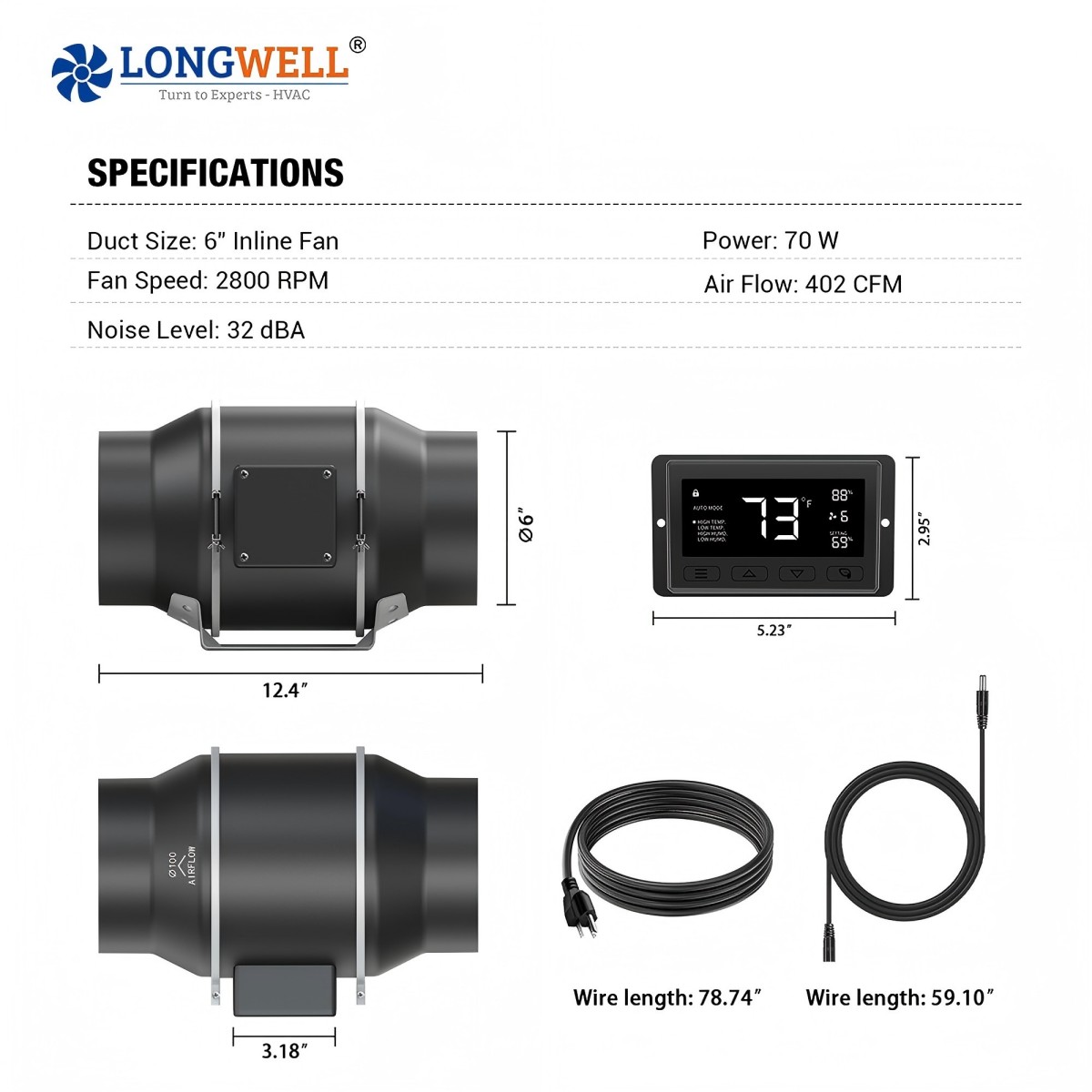
Tip: Longwell’s technical team uses advanced tools and years of experience to help you pick the right fan. They offer custom solutions, analyze your needs, and guide you through installation and maintenance. You can rely on their support for any project, big or small.
Choosing between an axial fan and a duct fan depends on your space, ductwork, noise needs, and budget. Take time to review your requirements, and do not hesitate to ask for expert advice.
Decision Guide
Step-by-Step Questions
It is easier to pick a duct fan or an axial fan if you ask the right questions. First, think about what you need and the space you want to cool or ventilate. Use the table below to see the main features of each fan type:
Fan Type | Airflow Direction | Typical Pressure Range | Common Applications | Noise Level | Efficiency and Cost Considerations |
|---|---|---|---|---|---|
Axial Fans | Air moves parallel to shaft | Up to ~2-4 inches water | Ventilation, cooling, attic exhaust | Noisy | Inexpensive, efficient at low static pressure |
Duct (Centrifugal) Fans | Air enters parallel, exits perpendicular | Above ~4 inches water | HVAC, storage, forced-air heating, filtration | Quiet | More expensive, efficient at higher static pressure |
To help you choose, follow these steps:
Decide what you want the fan to do. Think about where you will use it. Check how much space you have. Do you need it to be quiet? Will the fan deal with heat, dust, or water?
Match your needs to the fan’s features. Look at size, airflow, pressure, noise, power, and how you will mount it.
Look at product data sheets. Compare airflow, pressure, noise, and power use.
Ask an expert if you are not sure or if your project is special. This can help you avoid mistakes and save money.
Tip: If your space has long ducts or lots of bends, you probably need a duct fan.
Example Scenarios
Here are some real-life examples to show how the right fan helps:
Axial fans are good for big rooms, warehouses, or factories. Use them when you need to move lots of air at low pressure, like for cooling or getting rid of stale air.
Duct fans are best for HVAC systems or big work areas. Pick them when air must go through long ducts, filters, or bends. They work well with high pressure and stay quiet.
For pollution control, duct fans push air through filters and scrubbers. This keeps the air clean and safe.
Engineers look at space, noise, and budget before picking a fan. The right fan helps control temperature, saves energy, and lowers repair costs.
Note: Picking the right fan for your system helps it work better and keeps you comfortable every day.
You can spot the biggest differences between duct fans and axial fans in this table:
Feature | Axial Fans | Duct Fans |
|---|---|---|
Airflow Direction | Parallel to axis | Perpendicular to intake |
Air Pressure | Low | High |
Best Use | Open spaces | Ductwork, tight spaces |
Picking the right fan keeps your air fresh and people happy. For the best choice, look at Longwell’s many products or talk to their experts for help.
FAQ
What is the main difference between a duct fan and an axial fan?
A duct fan pushes air through long ducts or tight spaces. An axial fan moves air straight ahead in open areas. You should pick a duct fan for high pressure and an axial fan for high airflow in open rooms.
How do I know which fan size I need?
Measure your room’s square footage. Check your duct length and count bends or filters. Use this information to find the airflow you need in CFM. You can ask Longwell’s experts for help with sizing.
Are duct fans quieter than axial fans?
Duct fans with EC motors or mixed flow designs often run quieter, especially inside ducts. Axial fans can also be quiet in open spaces. Always check the fan’s sound rating before you buy.
Can I install these fans myself?
You can install small fans if you follow the instructions. For large or complex systems, you should ask a professional. Proper installation helps your fan work better and last longer.
How do I keep my fan working well?
Clean your fan and ducts often. Change filters when needed. Check for dust or blockages. Regular care keeps airflow strong and noise low.
See Also
Selecting The Best Axial Fan For Your Needs In 2025
Guide To Picking The Ideal Cross Flow Fan For Use
The Importance Of Axial Fans In Effective Machine Cooling
Choosing The Perfect Centrifugal Fan For Your 2025 Projects
Benefits Of LONGWELL Forward Centrifugal Fans For Energy Efficiency
